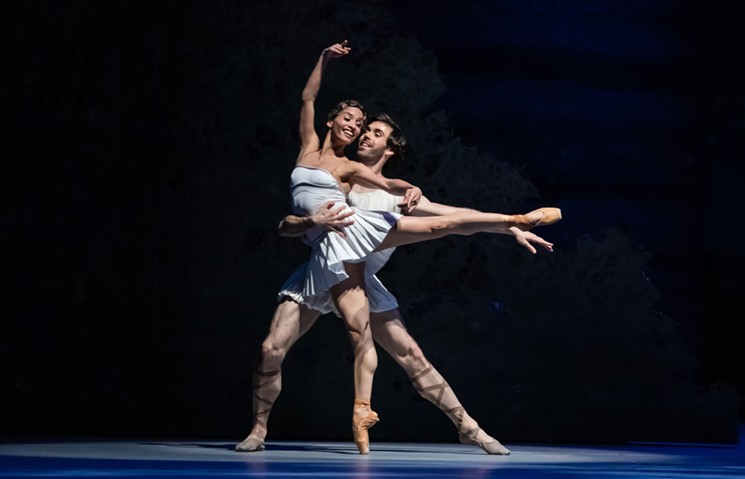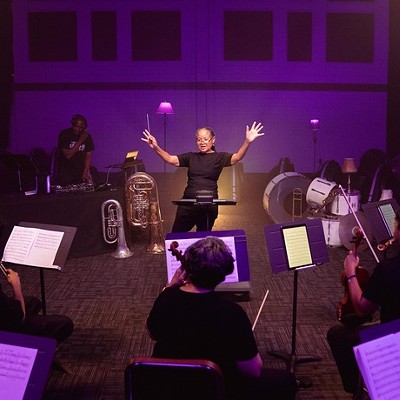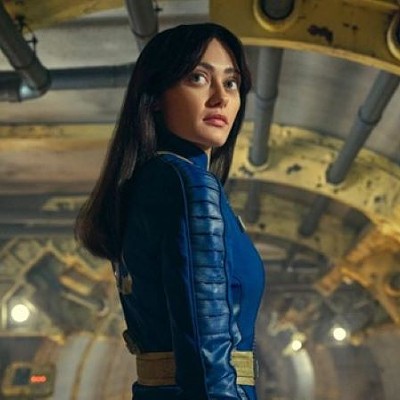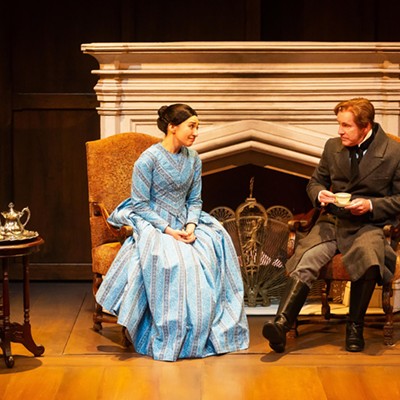Sylvia opens with a battle, more like a slaughter, as twin gods Apollo and Artemis lay waste to Queen Niobe’s soldiers on behalf of their mother, Leto. After emerging victorious, it becomes clear that father Zeus has a favorite – Apollo – and that there’s a little sibling rivalry at play. Luckily, Artemis’s close friend, Orion, arrives to distract her, but that does nothing but make Apollo jealous – jealous enough that he sets in motion a plan that – if successful – would have tragic consequences for Orion.
Meanwhile, Eros (who had been doing little more than trolling Artemis and Orion until Artemis ran him off with a few well-shot arrows) is called by his mother, Aphrodite, who demands that he kill a human, Psyche, who rivals her in beauty. He disguises himself and seeks out Psyche only to fall in love with her. They quickly marry, but Eros makes her promise to never look under his mask. You can imagine how well that goes.
And finally, there’s Sylvia, a nymph in Artemis’s army. When Eros sees her remove her armor to bathe, he sees her vulnerability as a way to get back at Artemis for shooting arrows and sic’ing her nymphs on him. He casts a spell so that Sylvia will fall in love with the first person she sees, who happens to be a shepherd. She deserts Artemis’s army for The Shepherd, but Alpheus the River God also catches wind of Sylvia’s armor-less vulnerability and decides to seize the opportunity for his own nefarious purposes.
From here (and really, from curtain), Welch’s Sylvia hits the ground running and never looks back. To be clear, this is both a blessing and a curse.
Since Sylvia’s underwhelming premiere in 1876, only one thing’s been sure – the problem’s not the music. Delibes’s score is what has continued to draw the efforts of some of the world’s best choreographers; Frederick Ashton (1952), David Bintley (1993), John Neumeier (1997) and Mark Morris (2004) have all tried their hand at Sylvia’s less-than-compelling source material (Torquato Tasso’s play Aminta) with varying levels of fidelity. Welch, equally enticed by Delibes’s irresistible music, chose to break with tradition and ditch the Roman myths in favor of the Greeks, and add two additional plot threads, the relationships between Eros and Psyche and Artemis and Orion. And make no mistake, the thoughtful, carefully interwoven stories are a pleasure. It’s Delibes’s 95-minute score that’s unforgiving. To Welch’s story, that is.

Principals Melody Mennite as Psyche and Charles-Louis Yoshiyama as Eros with Artists of Houston Ballet in Stanton Welch’s Sylvia.
Photo by Amitava Sarkar (2019).
If you've seen any of the press for Sylvia, you've probably seen references to Wonder Woman. But aesthetically, the production has a little more in common with a film out of the Marvel Cinematic Universe – Thor.
“Future antiquity” is the phrase Thor’s visual effects supervisor, Wesley Sewell, coined to describe Asgard, and it’s perfect to describe Sylvia’s Olympus, where the design choices lend the production an almost science fiction feel. With Harrington’s projections and Pinkham’s lighting, Kaplan’s cave-like set moves from a cool, celestial great hall, to a richly colored forest, to the reddish-orange fire of Hades and more. There’s not much time to luxuriate in any of the designs (for example, by the time you register the flames licking up in Hades they’re gone). Additionally, though the projections are used to great effect (the arrows firing across the stage, the water Sylvia uses to clean up, the sudden disappearances of characters), there’s a moment in the second act where everything goes haywire and, in the context of the other design choices, it’s hard to tell if it was a technical glitch or a questionable artistic choice. That uncertainty in and of itself is a problem.
The responsibility also falls to the audience to figure things out. It’s a must, an absolutely mandatory must, to read the synopsis and character guide before the show starts. Don’t go in blind and risk any confusion. The costume are lovely, but not truly distinct enough to truly help you distinguish the characters.
There are two elements here that are entirely successful. One is Delibes’s score, performed by the Houston Ballet Orchestra under the direction of Ermanno Florio, and the other is the dancers.
As the titular Sylvia, Karina González dances with a strength and surety of movement not usually seen in women characters. Once Sylvia falls in love with Connor Walsh’s Shepherd, Sylvia is the pursuer, and González is in control. She leads, pulls him forward, tugs him along, spins him around – it’s a role reversal that delights the audience. (She even employs a fun variation on an old school trick to get his arm around her.) Sylvia’s strength carries into González and Walsh’s partnering, as there’s an athleticism – complete with tosses, catches and fish dives – that defines the pair.

Principals Karina González as Sylvia and Connor Walsh as The Shepherd in Stanton Welch’s Sylvia.
Photo by Amitava Sarkar (2019).
The third act is overall the most successful, and part of that reason is the fun of watching Sylvia and the Shepherd’s life together. From the portrait-perfect poses, to the playful way they signify age progression, to the little character moments (like both Sylvia and the Shepherd’s displeased/concerned reactions to their children finding mates) and Steven Woodgate briefly taking over Walsh’s role –all in front of a warm sunset – it’s a strong way to bring this plot thread to a close.
Melody Mennite is pretty in pink as Psyche, a buoyant, bubbly presence on stage with a youthful flit to her feet. Psyche is imperfectly human, curious to a fault with little self-control, but the inner conflict is nothing if not amusing. Opposite Mennite is Charles-Louis Yoshiyama’s puckish Eros, whose actions set in motion two of the ballet’s three stories. Yoshiyama is well prepared for the role and commands attention, particularly in his powerful act three entrance.
There is a quiet sadness, and them loneliness, that follows Jessica Collado’s Artemis, but it doesn’t come off as weakness, instead informing the character as she leads her army and takes on Apollo. It’s together with Chun Wai Chan as Orion, however, that Collado truly shines. Two of the best sections of the entire production are the romantic, tease of an interlude between Artemis and Orion in the first act and the pair’s starry night pas de deux, which is characterized by grace, physical strength and effortless ease.
Though these are the main characters, the cast is big with so many character moments spread across the production, such as Alyssa Springer’s haughty smirk as Aphrodite, Harper Watters’s Apollo savagely shoving Chae Eun Yang’s Callisto once she’s no longer of use to him, and pretty much all the comedy brought by Psyche’s family (Bridget Kuhns, Christopher Coomer, Tyler Donatelli, and Jacquelyn Long).
Ian Casady’s Alpheus, the River God, is imposing but that particular plot point is so efficiently introduced and resolved, that not much time is spent with him or his River Gang. There is time, however, to watch Sylvia take on said gang and quickly dispose of five members. The fights are a joy to watch, and even the clang of the swords ringing out as Artemis’s army trains with each other – Soo Youn Cho (Oupis), Allison Miller (Loxo), and Nozomi Iijima (Hekaerge) also lead Artemis’s army in a dynamic section that includes impressive leaps, échappés, and fouéttes – is a treat.
And then there are the fauns. Christopher Gray, Oliver Halkowich, Fernando Martin-Gullans and Hayden Stark are a wild presence on stage, but it’s their controlled chaos that ties the show together.
There are so many reasons to see Houston Ballet’s production of Sylvia that I’m sure you will. But please, do yourself a favor and read the synopsis first.
Performances continue at 7:30 p.m. Thursday, Friday and Saturdays and 2 p.m. Sundays at the Wortham Theater Center, 500 Texas. Through March 3. For more information, call 713-227-2787 or visit houstonballet.org. $25 to $200.







